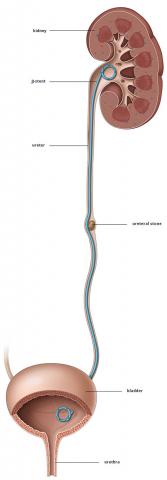What does the procedure involve?
This procedure involves the positioning of a soft silastic stent (hollow tube) that extends from the bladder to the kidney. A cystoscopy (telescopic inspection of the bladder) allows the required access and final positioning is performed under X-ray control.
Why is it needed?
Ureteric stents are usually used in the following circumstances:
-
To relieve obstruction of the kidney.
-
To relive obstruction and pain from an impacted ureteric stone.
-
Allow healing of the ureter after surgery.
Before the procedure
You will usually be admitted to hospital on the same day as your surgery.
You should not eat or drink for six hours prior to your admission. Immediately before the operation, the anaesthetist may give you a pre-medication, which will make you dry-mouthed and pleasantly sleepy.
What happens during the procedure?

Usually you will receive a light general anaesthetic, though occasionally a spinal anaesthetic is preferred – your anaesthetist will discuss the best option for you prior to its commencement.
Most patient will receive antibiotics – as a preventative measure against possible infection.
A cystoscope is inserted through the urethra (the tube through which you pass urine) to inspect the urethra, the prostate (if you have one) and the bladder. Using a special form of mobile X-ray the stent is carefully positioned into the renal pelvis (the kidney) to facilitate adequate drainage. The final position is then confirmed with X-ray. You only receive a very small amount of radiation during the procedure – much less than a standard X-ray.
What should I expect after the procedure?
For a few days after your procedure, it is normal to experience any of the following:
-
A mild burning when you pass your urine.
-
A need to pass urine more frequently, and occasionally more urgently than you usually do.
-
Some blood in the urine.
All usually settle quite rapidly without the need for any treatment.
What can you do to help?
-
Drink plenty of water.
-
Take Ural or Citravescent in a glass of water 4 times a day.
-
2 Panadol every 4 hours.
-
Take any antibiotics you have been prescribed.
Are there any side effects?
All procedures have the potential for side effects. Although these complications are well recognised, the majority of patients do not have problems after a procedure.
Some of the possible risks from this procedure include:
Relatively Common
-
Mild burning or bleeding on passing urine for short time after the operation.
-
Discomfort during physical activity or urination, urinary frequency and occasional blood in urine. These symptoms are usually mild, and usually resolve after a day or two.
-
Further procedure to remove stent.
Occasional
-
Infection of bladder requiring antibiotics.
-
Stent can get blocked or encrusted.
-
Occasionally the stent cannot be positioned correctly - requiring alternative treatment.
Rare
-
Infection in the kidney (pyelopnehritis), which can be serious and require intravenous antibiotics.
-
Damage to the ureter with need for open operation to repair it.
-
If the ureter is damaged, occasionally a tube needs to be placed into kidney directly from the back to allow the leak to heal.
-
Scar or stricture of the ureter requiring further procedures.
-
Stents can occasionally become dislodged and require replacement.
